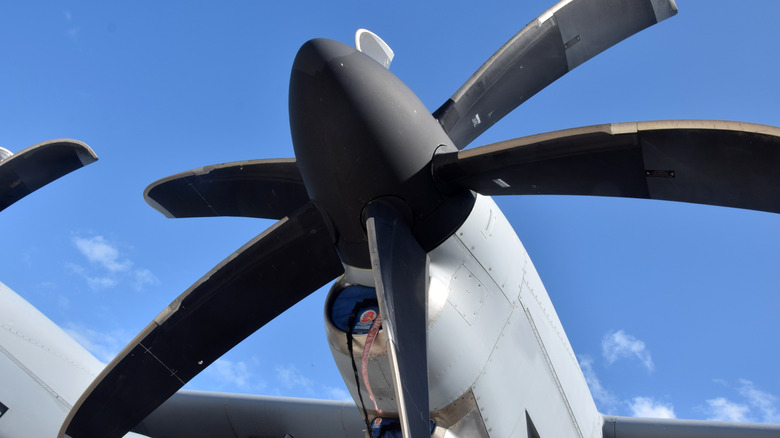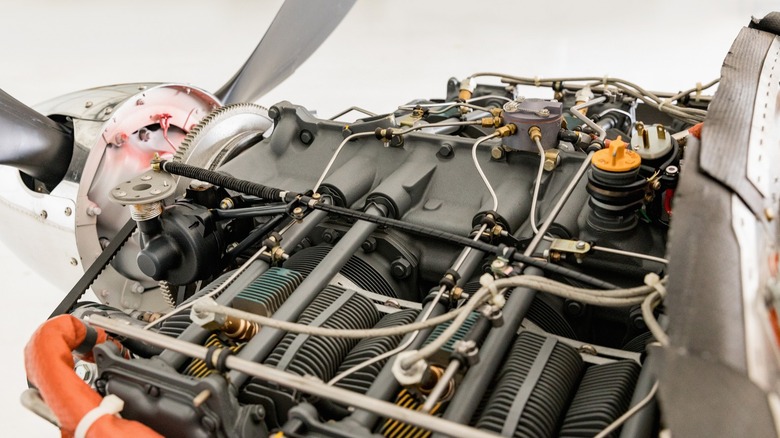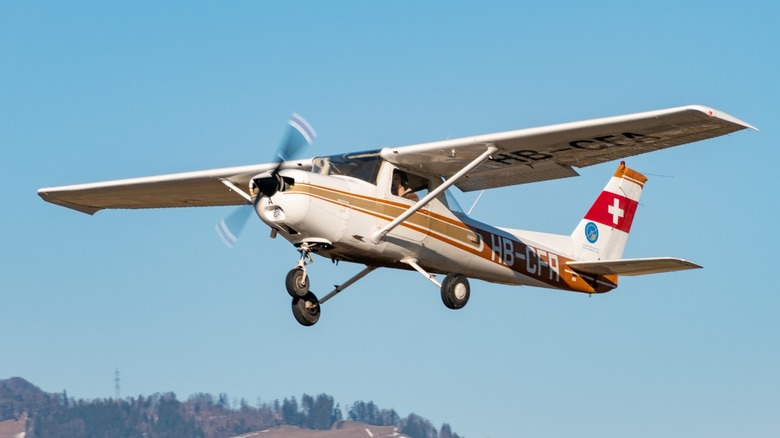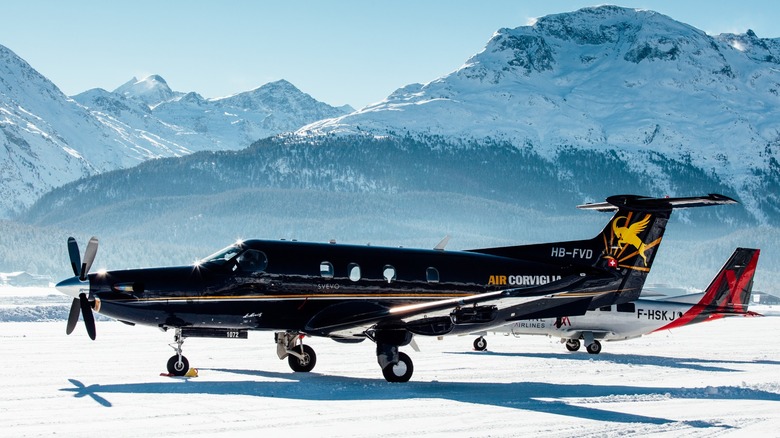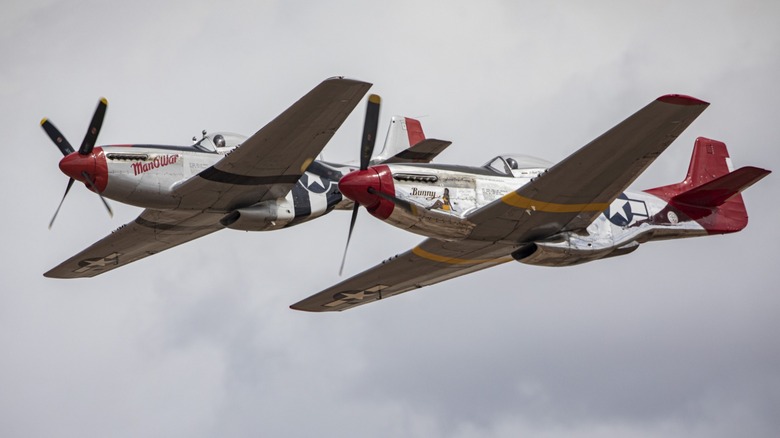Piston Vs. Turboprop: What's The Difference Between These Two Airplane Engines?
When you're at an airport and see propeller aircraft, you likely think it is powered by a piston engine. This is usually true among smaller planes, like the Cessa 172 Skyhawk and the Piper Archer, or older planes like the revolutionary DC-3. Propeller planes don't have jets, right? That's the definition.
In fact, some do! Many larger and faster propeller planes, like the 60s British turboprop HS 748 and the M700 Fury, Piper's fastest propeller-driven craft, use a turbojet engine to rotate their propeller. This is also true for propeller-driver airliners like the ATR and Q400. Even military propeller aircraft, like the C-130 Hercules and the Airbus A400M Atlas, have jet engines behind their propellers.
So, what are piston and turboprop engines? How do they work, and which engine type is better? Let's check out the differences between these two engines and learn how you can tell between the two just by using your ears.
What is a piston engine?
A piston engine in an airplane works on the same internal combustion principle as the gasoline engine we find in most automobiles. Instead of using regular gasoline, which has a relatively low octane rating (for more on that, check our breakdown of everything you need to know about different octane ratings) piston-engined aircraft use 100-octane fuel called Avgas 100 or Avgas 100LL because of its high performance and reliability.
The piston engine is also called a reciprocating engine, since its pistons move up and down (or side-to-side) to convert the chemical energy in gasoline into linear motion. That linear motion is converted to rotational motion by the crankshaft. That rotates the attached propeller, providing the thrust required for takeoff and flight.
Unlike cars and trucks, most piston-engined aircraft do not need a transmission, as you do not need to slow down your propeller's rotation speed if you're stationary on the ground (and you definitely need your propeller rotating quickly when you're in the air!). Cheaper, more basic planes also have manual mixture control, which lets the pilot select the amount of gasoline and air going into the engine. More advanced aircraft automate that process through a system called FADEC, or Full Authority Digital Engine Control. FADEC systems are efficient, but also heavy and expensive, so they've yet to be adopted throughout the general aviation community.
What is a turboprop?
Turboprop planes are similar to piston-engined aircraft because they both use propellers to generate thrust, but the similarity ends there. Instead of employing a reciprocating engine to rotate the propeller, a turboprop uses a turbojet engine, hence the name. Unlike piston-engined planes, turboprops use Jet A1, made of kerosene and a small number of other additives, rather than high-octane gasoline mixeslike Avgas.
Turboprops generally work similarly to jet engines: The jet compresses air, then fuel is fed to this compressed air inside a combustor. The expanding air spins a turbine that rotates the propeller.
Because the turbine rotates so quickly, a reduction gear is generally present between the propeller and turbojet engine to lower the propeller's rotational speed. That's because propellers are inefficient at higher speeds. Aircraft also become painfully noisy when the tips of the propellers exceed the speed of sound, as in the Soviet Tu-95 turboprop bomber.
What are the advantages and drawbacks of a piston engine?
The most significant advantage of the piston engine is its affordability. These engines are cheap to acquire and maintain, making them ideal for private aircraft operators and flying schools. They're also a bit more versatile, as some specially modified engines could use automotive fuel, provided they have a supplemental type certificate approving their use.
Another advantage of the piston engine is its ease of use. Almost all pilots start training on a piston-engined aircraft, meaning many know how to operate one. When I flew a piston-engined Cessna 152, its Lycoming engine responded instantly to my throttle inputs, meaning I got instantaneous engine response whenever I added or reduced power.
However, piston engines have some disadvantages, too. First is its fuel choice, which still contains lead and is terrible for the environment. While the FAA is working to eliminate lead from aviation fuel, it is still five years from hitting its 2030 goal. Another disadvantage of the piston engine is its performance — or lack thereof. Piston engines rely on oxygen to efficiently burn fuel, but as you fly higher, there's less oxygen in the air. Most piston-engined aircraft would have difficulty flying at airliner altitudes.
Furthermore, piston engines have many moving parts that go in different directions, thus making them more complicated and rougher than turboprop engines.
What are the pros and cons of a turboprop?
Turbines drive the propellers on turboprops, so they generally perform better than piston engines. This additional power output allows turboprops to fly at higher altitudes, allowing you to fly over turbulence, resulting in smoother flights. It also enables turboprop aircraft to take off on a shorter runway than piston-engine planes of the same size and weight. Because of the increased performance, turboprop planes are usually faster and climb better than piston-engined examples.
Another advantage of turboprops is reliability. Although turbine engines generally have more parts than piston engines, turbine engines only move in one rotational direction. This causes less wear in the engine, allowing it to fly longer between overhauls.
However, turboprops are expensive to purchase and even more costly to maintain. Furthermore, you need additional training, certifications, and licenses, like a high-performance rating, to operate a turboprop legally. That's because turbine engines behave differently from piston engines; you could easily lose control if you're unfamiliar with them.
Should you choose a piston-engined plane or a turboprop?
Both engine types have pros and cons, so there's no clear better option between them. As a passenger, you likely don't need to decide: Airplanes are the safest way to travel regardless o engine.
But if you plan to buy or lease a plane and can't decide between the two engine types, you should consider how you will use the aircraft. If you frequently fly long distances, then a faster turboprop is preferable to a slower piston-engined plane. But if you purchase a plane to build initial experience, you should go for a piston-engined aircraft. Cost is also a concern: Turboprops are fast and desirable, but they're expensive to buy and maintain. If you don't want to invest so much money in your airplane, the piston engine is the more economical choice.
From afar, piston-engined and turboprop planes look the same. However, they have different use cases, and the performance differences between the two options are far away. But if you want to determine if a plane is a piston or turboprop, listen to the noise it makes when taking it off. If you see propellers but hear a jet engine, that plane is definitely a turboprop.
